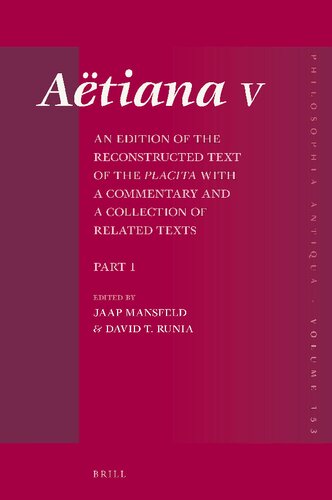

Most ebook files are in PDF format, so you can easily read them using various software such as Foxit Reader or directly on the Google Chrome browser.
Some ebook files are released by publishers in other formats such as .awz, .mobi, .epub, .fb2, etc. You may need to install specific software to read these formats on mobile/PC, such as Calibre.
Please read the tutorial at this link: https://ebookbell.com/faq
We offer FREE conversion to the popular formats you request; however, this may take some time. Therefore, right after payment, please email us, and we will try to provide the service as quickly as possible.
For some exceptional file formats or broken links (if any), please refrain from opening any disputes. Instead, email us first, and we will try to assist within a maximum of 6 hours.
EbookBell Team

4.8
24 reviews
ISBN 10: 9004428380
ISBN 13: 9789004428386
Author: Jaap Mansfeld, David Runia
A new reconstruction and text of the Placita of Aëtius (ca. 50 CE), accompanied by a full commentary and an extensive collection of related texts. This compendium, arguably the most important doxographical text to survive from antiquity, is known through the intensive use made of it by authors in later antiquity and beyond. Covering the entire field of natural philosophy, it has long been mined as a source of information about ancient philosophers and their views. It now receives a thorough analysis as a remarkable work in its own right.
1. Aim and Scope of the Edition
2. The Compendium and Its Transmission
2.1. The No Longer Extant Original Work
2.2. The Three Chief Witnesses
2.3. Ps.Plutarch and His Tradition
2.4. The Contribution of Stobaeus
2.5. The Crucial Role of Theodoret
2.6. The Name and Sitz im Leben of the Author/Compiler
2.7. The Extent of the Original Work
2.8. A Retrospective Glance at Aëtiana Volumes 1–2
3. Reconstructing the Text
3.1. The Doxographi Graeci of Hermann Diels
3.2. A New Edition without Columns and with Commentary
3.3. Apologia for Our Method of Reconstruction
4. Introducing the Witnesses to the Text
4.1. A Taxonomy of Authors and Texts
4.2. The Primary Witnesses: The Epitome of Ps.Plutarch
4.2.1. The Papyrus and the Manuscripts
4.2.2. Eusebius
4.2.3. Ps.Justin
4.2.4. Ps.Galen
4.2.5. Julian the Arian
4.2.6. Cyril of Alexandria
4.2.7. Theodoret
4.2.8. Interpolations in Philo of Alexandria
4.2.9. Ioannes Lydus
4.2.10. Scholia
4.2.11. Qusṭā ibn Lūqā
4.2.12. Psellus
4.2.13. Symeon Seth
4.2.14. Ioannes Tzetzes
4.2.15. Modern Editions and Translations of the Epitome
4.3. The Primary Witnesses: Stobaeus
4.3.1. The Direct Transmission
4.3.2. The Laurentianus Manuscript
4.3.3. The Evidence of Photius
4.3.4. The Edition of Wachsmuth
4.4. The Primary Witnesses: Theodoret
4.5. The Secondary Witnesses
4.5.1. Athenagoras
4.5.2. Achilles and the Aratea
4.5.3. Hermias
4.5.4. Nemesius
4.5.5. Isidore of Pelusium
4.5.6. Scholia on the Hexaemeron of Basil
5. The Proximate Tradition, Further Parallels, and Sources
5.1. The Dialectical-Doxographical Tradition
5.2. Aristotle and Theophrastus
5.2.1. Aristotle
5.2.2. Theophrastus
6. The Edition’s Contents, Method and Layout
6.1. The Division into Four Parts
6.2. The Edition
6.3. The Commentary
6.4. Further Related Texts
6.5. Rationale for the Collection of Further Related Texts
6.6. English Translation
6.7. Editio minor
7. Appendices to the General Introduction
7.1. Appendix 1: Diels’ Theory of the Placita
7.2. Appendix 2: Mansfeld and Runia, the Tradition of the Aëtian Placita
7.3. Appendix 3: Statistical Overview
ratification of the reconstruction amendments
text of reconstruction amendments
revised and expanded edition
text of article v of the constitution
aëtiana
3.10 art of ancient rome 2
Tags: Jaap Mansfeld, David Runia, Aetiana, Reconstructed